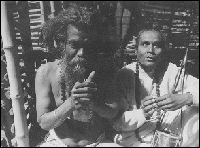|
|
|
監督・録音・撮影:ランジャン・パリット
Director, Sound, Photography : Ranjan Palit |
1982年プーナのインド映画テレビ学院を卒業、撮影技術の学位を取得。卒業製作であるビワンディの力織機紡織工を描いた30分のドキュメンタリー作品は、83年のボンベイ国際映画祭に出品された。その後ドキュメンタリー映画の撮影に従事。アナンド・パトワルダン監督の『Bombay, Our City』の撮影の大部分を担当。これまでに約50本のドキュメンタリー作品を撮影している。主な作品に『Eleven Miles』(90年)、『Memories of Milk』(91年)、『Kamlabai』(92年)、『Tales from Planet Kolkatta』(93年)、『Dream Before Wicket』(94年)などがある。 Finished the Film and Television Institute of India, Pune in 1982 with a diploma in cinematography. His diploma film, a 30-minute documentary on the powerloom workers of Bhiwandi, was selected for the Bombay International Film Festival 1983. Started specializing as a documentary cameraperson, shooting a major portion of Bombay, Our City for Anand Patwardhan. Has subsequently shot around 50 documentaries, including: Eleven Miles (1990), Memories of Milk City (1991), Kamlabai (1992), Tales from Planet Kolkatta (1993), Dream Before Wicket (1994). |
 |
|
| インドの聖地の火葬場で鎮魂の歌を歌う盲目の歌い手の神秘的な音楽世界を描く。神と運命の不思議を歌う一方、家庭を持ち、子どもと遊ぶひとりの生活人としての側面をも、手持ちのHi-8ビデオカメラが自由に切り取っていく。 | CurrentsA look into the mystic world of a blind singer from India who sings of love and death at a holy crematoria. The handheld Hi-8 camera moves freely and gives us a lucid look at this artistic and religious man, as well as at his daily family life. |
|
|
|
|
取材記事より 意識的か無意識的かはわからないが、パリットは言語の文化的決定性や集団生活における政治性に敏感である。彼は、よそ者に対して警戒しているグループのなかへも容易に順応する才能を明らかに持っている。ズームの使用を避け、通常は手持ちのカメラで撮影対象に接近し、会話の流れや意味合いに肉体的に反応しながら撮影する。カメラが振るう権力を直観的に感じとって、その力を分散させ、人と共有する方法を行使しているようだ。 |
From Press Files Palit is sensitive, consciously or unconsciously, to the cultural
determinations of speech and the cultural politics of collective
life. Palit's talent for fitting easily into group situations
which may be otherwise guarded about outsiders is clear. Eschewing
the zoom and usually holding the camera, he shoots in close proximity
to his subjects, responding physically to the flow and meaning
of the conversation. He seems to sense instinctively how the camera
wields power, and how to dissipate and share that power. |
